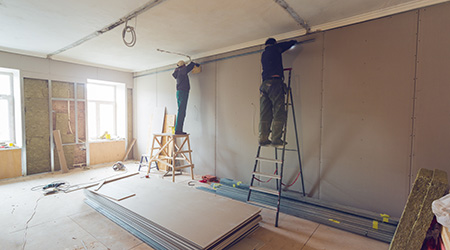Healthcare environments are sensitive settings where the planning and performance of renovation and construction projects require additional preparation and consideration. Contractors and in-house managers and staff must be aware of evolving infection control guidelines that dictate work practices and limit the risk of patient exposure. Infection control risk assessments are an essential component of the planning process. Of note, in October 2021, the American Society of Healthcare Engineers (ASHE) updated the Infection Control Risk Assessment (ICRA) guidelines, ICRA 2.0.
Construction challenges
Roughly 5 percent of healthcare associated infections can be directly related to construction activities, which have the potential to create dust migrations and changes in airflow that carry pathogens. Understanding the challenges in these settings and the standards of practice necessary to protect immunocompromised patients and workers allows healthcare facilities managers to incorporate specific policies and precautions into the planning process.
Plans include risk assessments and mitigation precautions that are job-specific for each construction activity performed and developed by a multi-disciplinary team. Keeping up to date with industry changes is key to a successful project.
Before construction projects begin, it is the responsibility of managers to complete a pre-construction risk assessment (PCRA) as defined through guidelines published by Association for Professionals in Infection Control and Epidemiology (APIC) and American Society of Healthcare Engineers (ASHE). There are seven components of a PCRA:
- Life Safety Code deficiencies (interim life safety measures)
- air quality and pressure management (ICRA)
- utility interruptions and impacts
- noise
- vibration
- environmental services
- other safety hazards.
These components are assessed by a multidisciplinary team, ideally consisting of project managers, engineering representatives, safety office representatives, infection preventionists, environmental services, and contractor representatives. While it is the direct responsibility of the healthcare facility, PCRAs can be completed most efficiently with the assistance of the outside contractor performing the work.
The Joint Commission also includes in its standards a requirement for a PCRA when planning for demolition, construction, or renovations. Eighty-two percent of hospitals are accredited through the Joint Commission and are subject to periodic surveys, which ensure facilities are adhering to these requirements. Therefore, proper documentation of the PCRA process is essential.
Life Safety Codes
A key component of the PCRA is the Life Safety Code. The National Fire Protection Association publishes the Life Safety Code (LSC) with the overall goal of fire prevention and patient safety in mind. The LSC sets requirements that must be adhered to during construction in a healthcare facility because patients in healthcare facilities might not be capable of self-preservation.
During the PCRA process, specific precautions must be identified and addressed when LSC deficiencies are deemed to occur during the project. Interim life safety measures (ILSM) define the life safety systems that will be compromised during construction and identifies the measures necessary to mitigate risk to patients, such as blocking exits, loss of integrity to fire walls or smoke barriers, and when a fire alarm or fire protection system is impaired. When these life-threatening conditions exist, they are combated with defend-in-place strategies using facility compartmentalization, firestop, and sealed penetrations.
ICRA considerations
The U.S. Centers for Disease Control and Prevention (CDC) and the Joint Commission also require healthcare facilities to perform ICRA developed by ASHE in 1996. An ICRA focuses on containment of the work area, indoor air quality, and implementation of mitigation recommendations. The ICRA developed for a project operates as a blueprint to ensure all those involved are working toward the same goal and in the same manner.
ICRA components address building features that promote patient safety, such as air handling, ventilation, water delivery systems, and hand sanitization systems. For interior projects, the ICRA evaluates the location of the project, the type of work to be performed, the extent of activity, and the potential impact on surrounding areas to determine class of precautions to be put in place. Containments for each project are specified based on the type of work to be performed, the amount of dust expected to be generated, and the patient care area. Critical barriers must be monitored for effectiveness throughout the duration of the project. For exterior projects, the staging areas, proximity to air intakes, and impact on water systems are evaluated.
In 2020, ASHE assigned a committee of experts to update ICRA guidelines, and in 2021, it published an updated ICRA 2.0. Since its original implementation, industry resources have evolved, and work practices have changed to further limit infections resulting from construction activities.
One key change to the ICRA was to add more descriptions to tables. This information clarified project activity types and risk groups, which determine the class of precautions in place during a project. A fifth class of precautions also was developed to address large-scale projects which were not completely covered by Classes I through IV. The updated ICRA 2.0 also includes a process guide to more clearly facilitate the way the ICRA should be implemented to avoid misapplications of the process that can be construed by inexperience or lack of training. The Matrix of Precautions for Construction, Renovation and Operations is a fundamental tool that managers can access free of charge to provide greater clarity in the application of the ICRA.
Knowledge of life safety measures and experience in performing risk assessments is essential for contractors and in-house facilities staff to successfully perform work in healthcare facilities. A 2020 ASHE survey found 62 percent of projects under way required contractors to complete ICRAs, and 26 percent of projects also required contractors to have certified credentials. Trade organizations are a great resource for standardized training for renovation and maintenance in healthcare facilities, as are private consultants who can tailor certified training to the contractor’s needs and experiences.
Contractors working in healthcare facilities might not be fully aware of the hazards they can introduce to patients and staff during construction activities until they complete proper renovation and maintenance training specific to healthcare. The importance of certified training is evident when working in healthcare environments to prevent infections and gain a thorough understanding of healthcare life safety codes, worker protection, and the risk assessment process. When working in healthcare facilities, it is well established that outside contractors and in-house facilities are crucial members of the healthcare team.
Shari L. Solomon, Esq. is president and founder of CleanHealth Environmental, LLC. CleanHealth provides infection prevention and industrial hygiene training and consulting services geared toward facility personnel and vendors responsible for infection prevention, cleaning and disinfection, and facility operations and maintenance practices. Ms. Solomon possesses more than 20 years of environmental consulting and federal regulatory experience. An attorney by trade, combined with her experience in the industrial hygiene field with a focus on healthcare, Shari holds a unique expertise and understanding of liability prevention techniques, offering clients practical and valuable risk management solutions.

 Making the Energy Efficiency Case to the C-Suite
Making the Energy Efficiency Case to the C-Suite How to Avoid HAIs This Flu Season
How to Avoid HAIs This Flu Season Design Phase Set to Begin for Hospital Annex at SUNY Upstate Medical
Design Phase Set to Begin for Hospital Annex at SUNY Upstate Medical Building Hospital Resilience in an Era of Extreme Weather
Building Hospital Resilience in an Era of Extreme Weather Ennoble Care Falls Victim to Data Breach
Ennoble Care Falls Victim to Data Breach